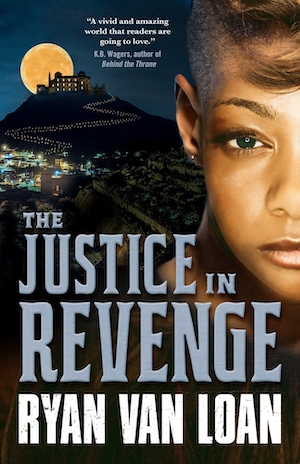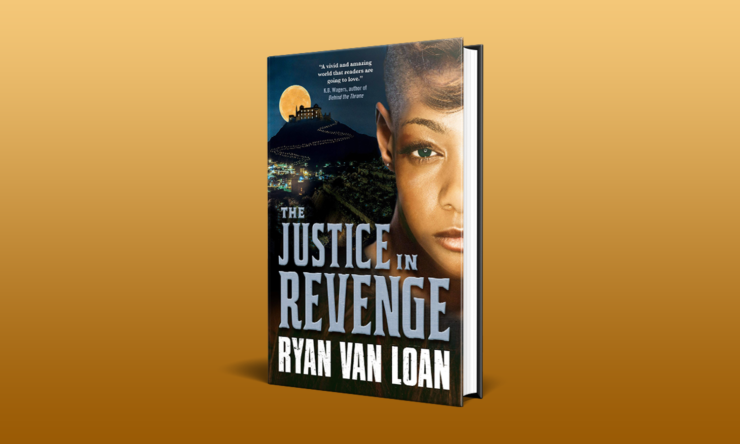Thorny matters of memory and recollection shape the narrative of Ryan Van Loan’s The Justice in Revenge, sequel to his debut novel The Sin in the Steel. The deadliest things the protagonist, Buc, faces are unknown unknowns lurking in her memory…
The Justice in Revenge takes place a significant interval after the events of the first novel. The Sherlockian duo of Buc and Eld have returned from The Shattered Isles and their piratical adventures to the Venetian like city of Severenza, and things have not gone as well as planned. Van Loan is very careful here, and it slowly emerges that things are not quite as what they seem; what Buc thinks she knows about what happened in the gap between the two novels is not as straightforward as what it appears.
This technique allows a reader, if they really wanted to, to start the series here and skip the first book entirely. While the events of the first book are referenced as a foundation, it is the interstitial gap between books that informs the present day Buc and Eld and what is going on. It makes the series more episodic and easier for a reader to pick up without having traveled to the Shattered Coast with Buc and Eld in The Sin in the Steel. If that was the intent, a precis of what happened in the first book, something out of fashion but not completely absent from the SFF world (c.f. T. Frohock’s Los Nefilim novels), would have helped buttress this approach on the writer and the book’s part.
Buy the Book


The Justice in Revenge
The major change between the two novels is Sin. Sin, a fragment of a Goddess, became lodged in Buc’s mind in The Sin in the Steel. The consequences of this spool out for the reader, both the good and the bad. Sin has opinions about what should be done, opinions about Buc’s future that she manifestly resists with all of her being. Further, given Eld’s opinions on magic, and Buc’s own opinion on divinities, the last thing that Buc wants to do is to have Sin dominate her. Buc and Eld make an effective team and so putting pressure on that relationship, on several ways and several axes, shows how things can go wrong when they are not that effective team.
For a large portion of the novel, Buc does not know that she is missing key memories of events that occurred between the two novels, creating additional stress and unease in the narrative that plays as a slowly rising tide within Buc, and across the tangle of main plots that Buc and Eld find themselves within. Buc’s plan to oppose the nobility and the Gods runs into a buzzsaw of politics, both within the Kanados Trading Company and in the governmental sphere, as the Doga of the island nation coerces Buc into a very Holmesian task: Find out who is trying to assassinate her, even though it becomes clear that the Doga knows much more than she is letting on about the assassination attempts. Of course, when one hunts assassins, one becomes a target themselves.
Most of the book is in Buc’s point of view and so we share her strengths, and her limitations. The times where we break away from that point of view are key revelatory moments, because it gives us sometimes very needed parallax from Buc’s own biases to get a wider view of what’s going on. Information management, yet again, and these passages also put a number of things into perspective.
While I have made this sound like it is solely a novel of memory, information control, mistaken assumptions and recollection, and the mistakes we make when we have very much have the situation wrong, the novel has action beats in spades. The action here moves from the shipboard and island adventures of Buc and Eld in the first novel, to the very mean streets and canals of Severenza. Chases via Gondola, shootouts in slums, deadly swordplay and lots more keep the action beats coming at sometimes unpredictable intervals.
The aforementioned Sin, now part of Buc, provides a new and interesting wrinkle to Buc and her approach to conflicts. If you have seen the two Guy Ritchie Sherlock Holmes movies featuring Robert Downey Jr., you may remember the “slow bullet time fight calculation” technique that he uses in several scenes. In The Justice in Revenge, Sin gives Buc that same sort of ability—slowing external time, giving advice—providing her with tactical advantages that are not absolute, but it is sure an edge (and one that their more potent antagonists recognize1). Every time one of these moments came up in the book, my mind went to the slightly desaturated, slowed time look of the films. As with the first novel, the action scenes are very engagingly and clearly written, even when mixing up the timeline (as in the manner of a heist, showing the planning that allowed something improbable after the improbable event).
In The Sin in the Steel, a plot point revolves around Buc’s addiction to the drug Kan. While she (again like Holmes) claims that the use of the drug is to focus and improve her abilities, that novel makes it clear it is an addiction. In The Justice in Revenge, Buc’s addiction is a reliance on the power Sin provides. Better than the first novel, the theme of that addiction and its problems are brought forward, and explored. This also includes the problems of being attached to power and authority. Street rat Buc has come up in the world, and while she feels and acts often as if she is still the outsider to the halls of power, having a seat on the board of the Trading Company makes the reality somewhat different.
A careful and mindful reader might wonder what other prices or consequences there are for such a power, and what Sin truly wants. Even beyond the issues of using the power, there is an internal tension between Sin and Buc throughout the novel that goes to heart of the problems of memory and recollection. Even as the external conflicts that Buc and Eld have to face mount and develop, the internal conflict also mounts. The novel does turn up the pressure on Buc both within and without. There are definitely a number of Apocalypse World style “ticking clocks” that Buc is under, and their countdowns keep the pressure on even when Buc isn’t being shot at in any particular moment.
A number of recent novels intersect with this novel quite interestingly and satisfactorily and reading them along with this book extends the genre conversation and the themes resonating here. E J Beaton’s The Councillor, all about a scholar turned politician in the mold of Machiavelli, explores not only the aspects of intrigue and conflict that this novel holds, but also does some interesting things with the nature of basic assumptions. The two Michael Kingsman novels of Nick Martell, The Kingdom of Liars and The Two Faced Queen, not only has a character who is missing gaps of his memory but also deals with the problems of memory loss due to the use of magic, and the consequences and considerations of that trade off. Readers, on the other hand, who want a fantasy Venice like the city of Severenza might find favor with Melissa Caruso’s The Tethered Mage. I suspect Buc, being a creature of the streets (and we really see the tensions in that origin in this novel) would not find favor with the noble blooded protagonist Amalia Cornaro, but could possibly sympathize with the magician Zaira.
I’ve danced around spoilers and left out information, a theme that runs from the book and its text right into this review. However I will say that the author does, to use a metaphor from a different movie series entirely, “Blow up Vulcan” and shake up events by the end of this book. After a pirate adventure, and a study of memory, forgetfulness, magic and politics in this second book, I am very curious as to where Van Loan proceeds with the series.
The Justice in Revenge is available from Tor Books.
Read an excerpt here.
An ex-pat New Yorker living in Minnesota, Paul Weimer has been reading sci-fi and fantasy for over 30 years. An avid and enthusiastic amateur photographer, blogger and podcaster, Paul primarily contributes to the Skiffy and Fanty Show as blogger and podcaster, and the SFF Audio podcast. If you’ve spent any time reading about SFF online, you’ve probably read one of his blog comments or tweets (he’s @PrinceJvstin).
[1]I do so appreciate antagonists that have half a brain, see that the protagonist has hitherto unseen abilities and has the grace to recognize the fact and try and figure out what that new edge is.










